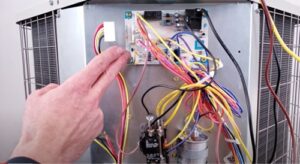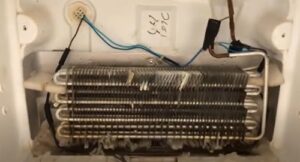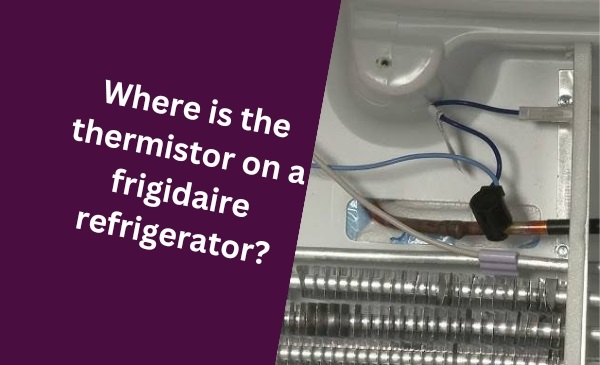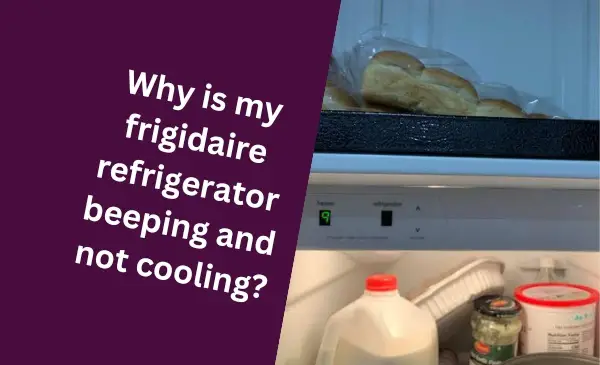The defrost drain on a Frigidaire refrigerator is located at the back of the freezer compartment. It is a small hole that allows the water from the defrosting process to drain away.
Your Frigidaire refrigerator has a defrost drain that helps remove excess water during the defrosting process. If you notice water pooling or leaking inside the freezer or refrigerator, it could be due to a clogged or blocked defrost drain.
Understanding the location of the defrost drain is crucial for troubleshooting and resolving any drainage issues.
By following simple steps to access and inspect the defrost drain, you can ensure the proper functioning of your Frigidaire refrigerator and prevent potential water damage. We will guide you on where to find the defrost drain and how to keep it clean and free from obstructions to ensure optimal performance.
Understanding The Defrost System
The defrost system plays a crucial role in ensuring their optimal performance and longevity. However, understanding how the defrost system works and where its components are located can be a bit confusing for the average homeowner.
In this section, we will delve into the inner workings of the defrost system in your Frigidaire refrigerator, shedding light on its functioning and the key components involved.
How Does The Defrost System Work?

The defrost system in your Frigidaire refrigerator is designed to eliminate the buildup of ice and frost on the evaporator coils. This buildup occurs naturally as the refrigerator cools the air inside to keep your food fresh.
Over time, the ice and frost can reduce the efficiency of the cooling process and even lead to complete blockage of the coils. The defrost system prevents this by periodically melting the ice, allowing it to drain away.
At regular intervals, typically several times a day, a timer or electronic control initiates the defrost cycle. This cycle can be triggered based on factors like the duration the compressor runs or a predetermined amount of time.
When the defrost cycle begins, the temperature in the freezer section rises slightly, and the compressor shuts off. This allows the evaporator coils to warm up.
As the coils warm up, the ice and frost melt, turning into water. This water then flows down into a drain pan located at the bottom of the refrigerator. The warm temperature in the drain pan helps evaporate the water, preventing any overflow or accumulation that could lead to leaks or other issues.
Components Of The Defrost System

The defrost system in your Frigidaire refrigerator comprises several key components working together to ensure effective and efficient defrosting. These components include:
- Defrost Timer or Electronic Control: This component controls the initiation and duration of the defrost cycle, ensuring that it occurs at regular intervals. It can be located inside the refrigerator or in the control panel.
- Defrost Heater: The defrost heater is responsible for warming up the evaporator coils during the defrost cycle. It prevents ice and frost buildup by converting electrical energy into heat, promoting the melting of accumulated ice.
- Defrost Thermostat: The defrost thermostat monitors the temperature of the evaporator coils. If the coils reach a certain temperature, indicating that they are warm enough for defrosting, the thermostat signals the heater to turn on. Once the coils reach the optimal temperature, the thermostat shuts off the heater, preventing overheating.
- Defrost Drain: The defrost drain is a small opening located at the back of your refrigerator’s freezer section. It allows the melted ice and frost to flow down into the drain pan, preventing any water from accumulating and causing leaks or other problems.
- Drain Pan: The drain pan collects the water drained from the defrost system, helping to evaporate it and prevent any overflow. It is typically located at the bottom of the refrigerator, near the compressor.
Understanding the components of the defrost system and their respective functions can provide valuable insights into the maintenance and troubleshooting of your Frigidaire refrigerator.
By keeping these components in optimal condition and ensuring the defrost drain remains clear, you can help prolong the life of your refrigerator and maintain its efficiency.
Locating The Defrost Drain
A properly functioning defrost drain is crucial for the optimal performance of your Frigidaire refrigerator. The defrost drain is responsible for carrying away the water that accumulates during the defrost cycle, preventing it from pooling inside your fridge. If the defrost drain becomes clogged or damaged, it can lead to water leakage and even cause potential damage to your refrigerator.
Why Is The Defrost Drain Important?
The defrost drain plays a vital role in maintaining the efficiency and functionality of your Frigidaire refrigerator. Without a functioning defrost drain, the water collected during the defrost cycle can accumulate and turn into ice, resulting in reduced cooling performance and potential damage to crucial components of your refrigerator.
Steps To Find The Defrost Drain
Locating the defrost drain on your Frigidaire refrigerator is a relatively simple process. Follow these steps to find the defrost drain:
- Unplug your refrigerator to ensure your safety.
- Remove all the items from the freezer or the bottom section of your fridge, depending on the model.
- Locate the back panel of your freezer or the bottom section of your fridge.
- Remove the screws or clips securing the back panel to access the evaporator coils. The defrost drain is typically located near the bottom of the coils.
- Inspect the drain hole for any debris or ice build-up. Use a soft cloth or a pipe cleaner to remove any blockages gently.
- Once you have cleared the drain hole, pour a small amount of water into it to ensure it is flowing freely.
It is essential to note that the exact location of the defrost drain may vary depending on the model of your Frigidaire refrigerator. Refer to your refrigerator’s user manual for specific instructions and diagrams.
Common Areas Where The Defrost Drain Is Located
The defrost drain in a Frigidaire refrigerator can typically be found in one of the following common areas:
| Model Type | Location of Defrost Drain |
| Top Freezer | The back wall of the freezer, just below the evaporator coils. |
| Bottom Freezer | Bottom of the freezer, near the back, or underneath the evaporator coils. |
| Side-by-Side | Behind the back panel in the freezer section, near the bottom portion of the evaporator coils. |
| French Door | Behind the back panel in the freezer section, near the bottom of the evaporator coils. |
Clearing A Clogged Defrost Drain
A clogged defrost drain in your Frigidaire refrigerator can cause water to pool at the bottom of the fridge or leak onto the floor. If you notice either of these signs, it’s essential to address the issue promptly to prevent further damage.
In this section, we will discuss the signs of a clogged defrost drain and provide you with some DIY methods to clear it.
Signs Of A Clogged Defrost Drain
If you suspect a clogged defrost drain in your Frigidaire refrigerator, keep an eye out for the following signs:
- Excess water pooling at the bottom of the fridge, often forming a layer of ice.
- Water leaking onto the floor from the front or back of the refrigerator.
- Visible debris or ice blocking the drain hole.
- An unpleasant odor emanating from the fridge.
If you notice any of these signs, it’s a clear indication that the defrost drain is clogged and needs to be cleared as soon as possible.
Diy Methods To Clear The Drain
Fortunately, clearing a clogged defrost drain is a relatively simple task that you can tackle on your own. Here are a few DIY methods that you can try:
- Unplug the refrigerator from the power source to avoid any accidents.
- Locate the defrost drain hole, which is usually situated at the back of the freezer compartment. It may be covered by a plastic panel or vent.
- Remove the panel or vent to gain access to the drain. You may need to use a screwdriver or a wrench, depending on the model of your Frigidaire refrigerator.
- Once the drain is visible, use a small, flexible brush or pipe cleaner to gently remove any debris or ice buildup. Avoid using sharp objects that could damage the drain.
- Flush the drain with warm water to ensure it is clear of any remaining clogs. You can use a turkey baster or a syringe to direct the water into the drain.
- Replace the panel or vent, ensuring it is securely fastened.
- Plug the refrigerator back into the power source and monitor the drain for any further issues.
By following these simple steps, you can effectively clear a clogged defrost drain in your Frigidaire refrigerator and prevent water damage or mold growth.
Tools Needed For The Unclogging Process
To clear the defrost drain on your Frigidaire refrigerator, you will need the following tools:
| Tool | Description |
| Small flexible brush | Used to remove debris and ice from the drain |
| Pipe cleaner | An alternative to a brush for clearing the drain |
| Turkey baster or syringe | Used to flush the drain with warm water |
| Screwdriver or wrench | Required to remove the panel or vent covering the drain |
Having these tools on hand will make the unclogging process much easier and ensure a successful outcome.
Preventing Future Clogs
Keeping the defrost drain clear is essential for the efficient functioning of your Frigidaire refrigerator. A clogged defrost drain can lead to water leaks and ice buildup, causing potential damage to your appliance.
Thankfully, with regular maintenance and a few simple tips, you can ensure that your defrost drain remains clear and free from clogs. Follow these guidelines to prevent future issues.
Tips To Keep The Defrost Drain Clear
Clearing the defrost drain can be a hassle, but it is much easier to prevent clogs in the first place. By following these tips, you can keep your Frigidaire refrigerator’s defrost drain clear and minimize any potential problems:
- Regularly clean the freezer: A clean freezer is less likely to have debris or food particles that can clog the defrost drain. Dispose of any expired or freezer-burnt items and wipe down the interior regularly.
- Avoid placing items directly on the back wall: When placing items in the freezer, make sure they do not come into direct contact with the back wall. This will help prevent the formation of ice and the blockage of the defrost drain.
- Never pour hot water into the freezer: Pouring hot water into the freezer to defrost it can cause rapid temperature changes and potentially damage the defrost system. Allow the freezer to defrost naturally or use a safe method recommended by the manufacturer.
- Keep the drain line clean: The drain line is a small tube located in the back of the freezer. Ensure it remains clear of any obstructions by gently cleaning it with a pipe cleaner or a soft brush. Be careful not to force anything down the drain to avoid damaging it.
- Check the defrost timer and heater: Regularly inspect the defrost timer and heater to ensure they are working correctly. Malfunctioning components can lead to ice buildup and clogs. Consult the refrigerator’s manual or contact a professional if you notice any issues.
Regular Maintenance For The Defrost System
Performing regular maintenance on your Frigidaire refrigerator’s defrost system can go a long way in preventing future clogs. Here are a few maintenance tasks you can undertake:
- Clean the drain pan: The drain pan, located at the bottom of the refrigerator, collects water from the defrost cycle. Regularly clean and empty the drain pan to prevent buildup and odors.
- Check the refrigerator’s temperature: Ensure that the refrigerator’s temperature is set correctly. If the temperature is too low, excessive ice formation can occur, leading to drain clogs. Refer to the manufacturer’s guidelines for the ideal temperature range.
- Inspect the door gasket: A faulty door gasket can cause warm air to enter the freezer, leading to frost buildup and potential drain clogs. Regularly check the seal and replace it if necessary.
- Monitor the drainage: Keep an eye on the draining water during the defrost cycle. If you notice slow drainage or water pooling inside the freezer, it may indicate a potential clog. Take immediate action to clear the drain.
By following these tips and performing regular maintenance on your Frigidaire refrigerator’s defrost system, you can prevent clogs and ensure the efficient operation of your appliance.
Taking proactive measures will save you time, money, and potential headaches in the long run. Keep your refrigerator in optimal condition by incorporating these practices into your routine maintenance.
Calling For Professional Help
If you’ve been experiencing issues with the defrost drain on your Frigidaire refrigerator, and you’ve exhausted all the DIY solutions, it may be time to call in the professionals.
Recognizing the symptoms and knowing when to seek professional assistance is crucial to ensuring your refrigerator is functioning optimally.
Hiring a professional technician not only saves you time and effort but also brings a host of benefits that can help extend the lifespan of your appliance.
When To Seek Professional Assistance
If you’re unsure whether to call a professional technician for help with your Frigidaire refrigerator’s defrost drain, here are some signs that indicate it might be time to seek assistance:
- The refrigerator’s freezer is constantly icing up, even after defrosting it multiple times.
- There is excessive water pooling or leaking inside the refrigerator or around its base.
- Unpleasant odors are emanating from the refrigerator, indicating a potential clog in the defrost drain.
- The refrigerator is not maintaining proper temperature levels.
If you’re experiencing any of these issues, it’s wise to reach out to a professional as soon as possible. Attempting to fix the problem yourself can lead to further damage and more expensive repairs down the line.
Benefits Of Hiring A Professional Technician
When it comes to fixing complex issues like the defrost drain on a Frigidaire refrigerator, hiring a professional technician offers several advantages:
- Expertise and Knowledge: A professional technician has the necessary experience and expertise to accurately diagnose and repair defrost drain issues. They are well-versed in Frigidaire refrigerator models and can quickly identify the root cause of the problem.
- Time and Effort Savings: By calling a professional, you save valuable time and effort that could be better spent on other tasks. Professionals have the necessary tools and resources to efficiently troubleshoot and fix the defrost drain, preventing you from experimenting with potentially ineffective DIY methods.
- Proper Tools and Equipment: Professional technicians are equipped with specialized tools and equipment needed to repair the defrost drain effectively. This ensures that the job is done correctly, minimizing the risk of further damage to your refrigerator.
- Extended Appliance Lifespan: Getting professional help extends the lifespan of your Frigidaire refrigerator. Professionals can address underlying issues that may go unnoticed by untrained eyes, reducing the likelihood of future breakdowns and the need for further repairs.
So, if you’re dealing with a troublesome defrost drain on your Frigidaire refrigerator, don’t hesitate to call in the experts. Seeking professional assistance ensures a reliable, long-lasting solution and saves you from the frustration of ongoing issues.

Credit: www.mrmcw.edu.in
Frequently Asked Questions On Where Is The Defrost Drain On A Frigidaire Refrigerator
Where Is The Defrost Drain Located On A Frigidaire Refrigerator?
The defrost drain is typically located at the back of the freezer compartment, underneath the evaporator coils. You may need to remove the freezer panel or ice maker to access it. It’s important to keep the drain clear of debris to prevent water from backing up and causing leaks or ice buildup.
How Can I Find The Defrost Drain In My Frigidaire Refrigerator?
To locate the defrost drain in your Frigidaire refrigerator, start by removing any shelves, drawers, or panels inside the freezer compartment. Look for a small opening or hole at the back of the freezer, directly beneath the evaporator coils. That’s where the defrost drain is typically located.
If you’re having trouble finding it, consult your refrigerator’s user manual for specific instructions.
Why Is It Important To Clean The Defrost Drain On A Frigidaire Refrigerator?
Cleaning the defrost drain on your Frigidaire refrigerator is important because a clogged drain can lead to water leaks and ice buildup in the freezer. When the drain becomes blocked by debris or ice, the defrost water has nowhere to go and can overflow onto the floor or create icicles inside the freezer.
Regularly cleaning the drain helps prevent these issues and keeps your refrigerator functioning properly.
Conclusion
To locate the defrost drain on a Frigidaire refrigerator, simply follow these steps and keep your appliance running smoothly. By understanding the importance of regular maintenance and knowing where to find the defrost drain, you can prevent issues like water leakage and ensure optimal performance.
Keep your refrigerator in top condition and enjoy hassle-free operation for years to come.
Hello Readers, I am Mechanic Shuvo, a seasoned refrigerator solution expert with over 11 years of hands-on experience in the field. Throughout my career, I've dedicated myself to understanding the ins and outs of refrigeration systems, honing my skills as a refrigerator mechanic. My passion for these appliances led me to create the website "refrigeratorsolutionsguide.com," where I aim to share my wealth of knowledge and expertise with others.
Over the years, I've encountered a wide range of refrigerator issues and have successfully resolved them all. From common problems like temperature fluctuations and strange noises to more complex technical issues, I've seen it all. Through my website, I hope to provide practical solutions, insightful tips, and guidance to help you keep your refrigerators running smoothly.







